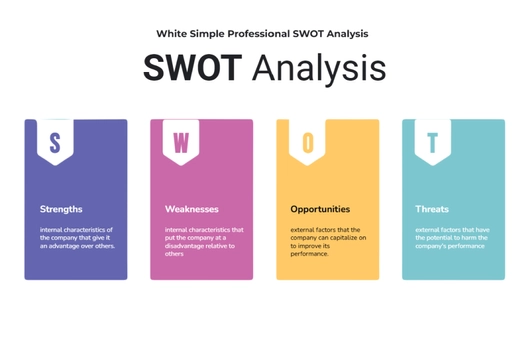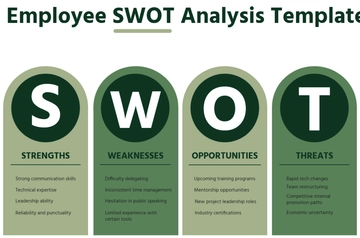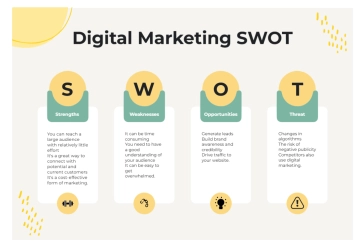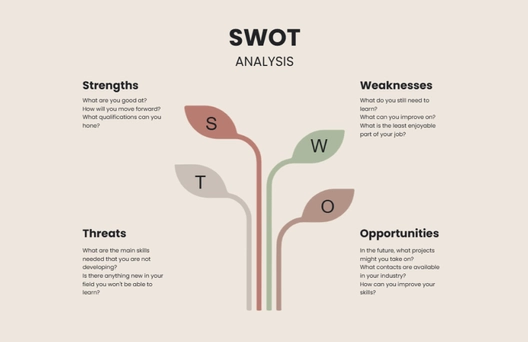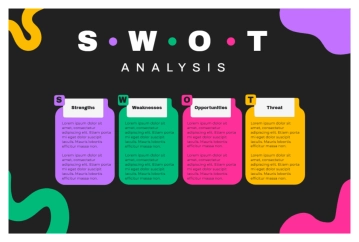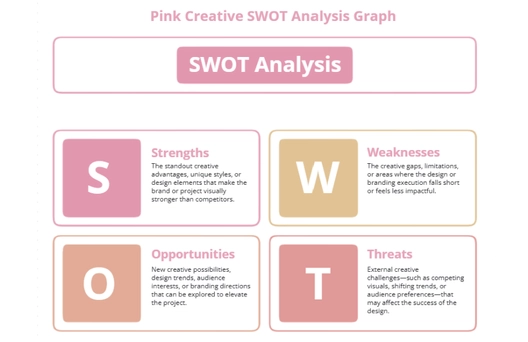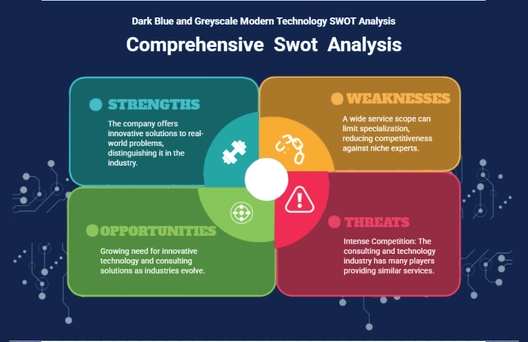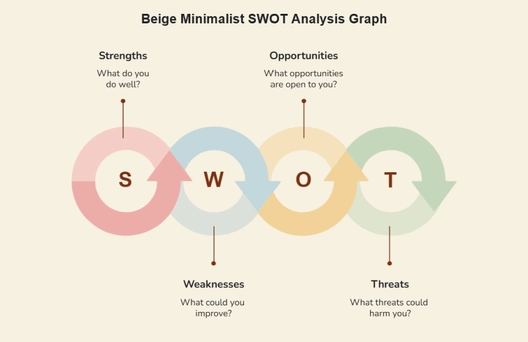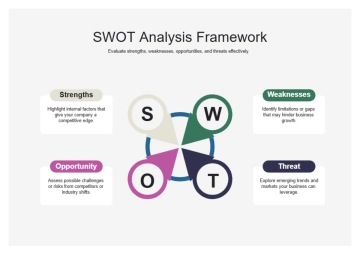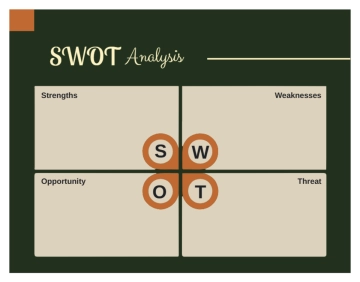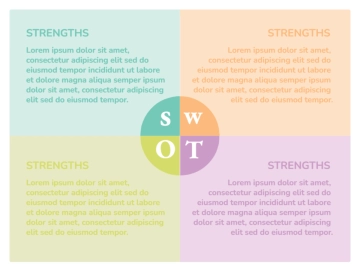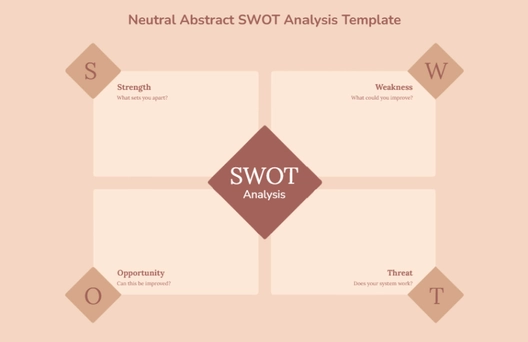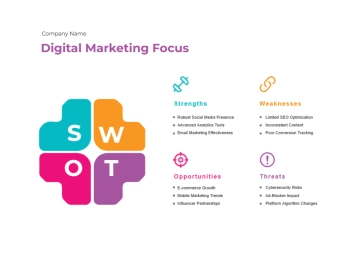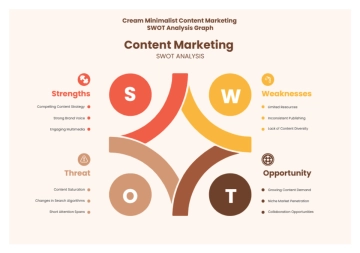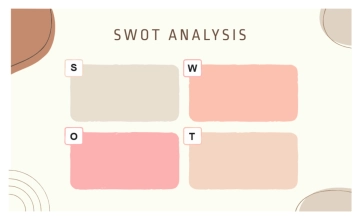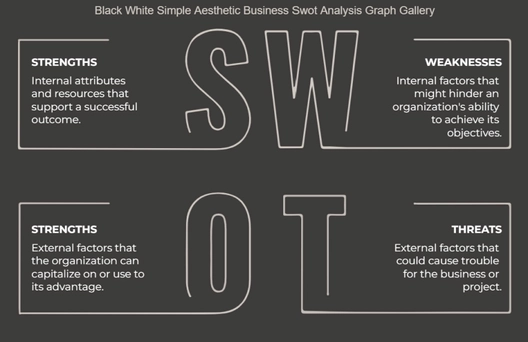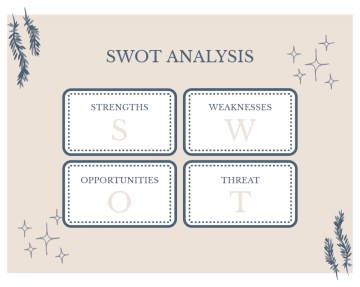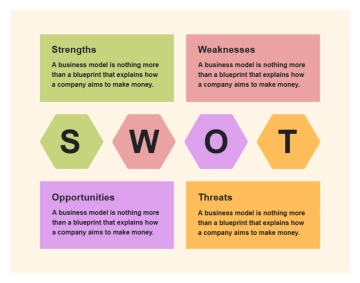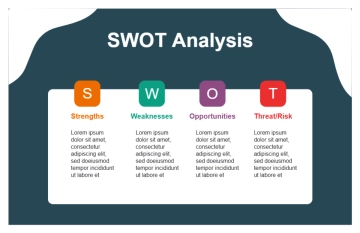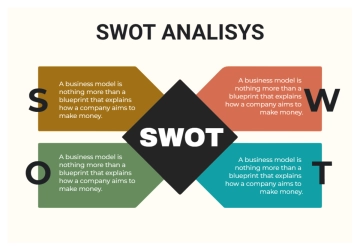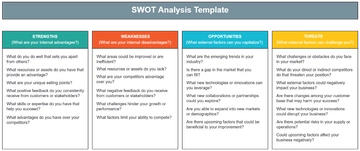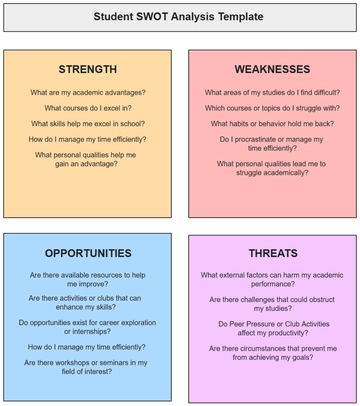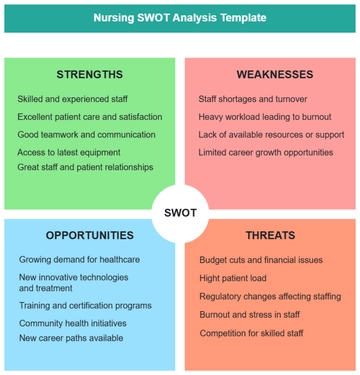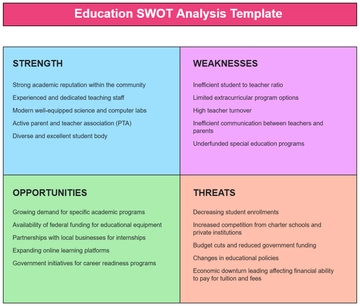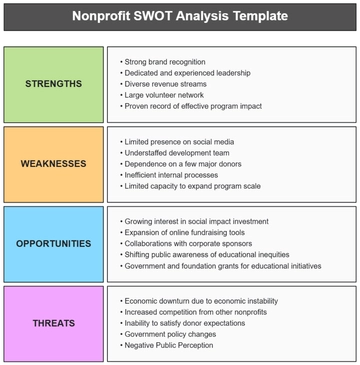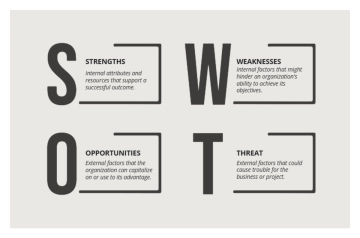Free Real Estate Construction Project SWOT Analysis

I. Introduction
Welcome to the SWOT Analysis document for our current real estate construction project at [YOUR COMPANY NAME]. As we navigate through the complexities of the construction industry, it is imperative to conduct a thorough and strategic examination of our project’s internal and external environment. This analysis is designed to identify the Strengths, Weaknesses, Opportunities, and Threats associated with our project. Our goal is to leverage this comprehensive evaluation to inform decision-making, optimize our strategies, and ensure the project's success.
The purpose of this document is twofold. Firstly, it aims to provide all project stakeholders—including team members, investors, and partners—with a clear understanding of the project's strategic landscape. By doing so, we can align our efforts, capitalize on our competitive advantages, and address any challenges head-on. Secondly, this SWOT analysis serves as a foundation for our strategic planning process, guiding us in setting priorities, allocating resources effectively, and identifying areas for improvement and growth.
Within the scope of this analysis, we will delve into the internal factors under our control, such as our team's skills, financial resources, and operational capacities, as well as external factors that might impact our project, including market trends, regulatory changes, and competitive dynamics. Each section of this document—Strengths, Weaknesses, Opportunities, and Threats—will provide detailed insights into these factors, followed by actionable items designed to leverage our strengths, mitigate our weaknesses, capitalize on opportunities, and defend against potential threats.
Our SWOT analysis is not just a static evaluation but a dynamic tool that will be revisited and updated throughout the project lifecycle. This ensures that our strategies remain relevant and responsive to the changing circumstances of the real estate construction landscape.
By the end of this document, we aim to have outlined a clear path forward, enabling [YOUR COMPANY NAME] to not only navigate the challenges and uncertainties of the construction industry but to emerge as a leader in delivering innovative, high-quality real estate projects. Let’s embark on this strategic journey together, armed with insights and prepared to turn potential obstacles into stepping stones for success.
II. Objective
The objective of this document extends to a multi-dimensional analysis aimed at enhancing our strategic planning and decision-making processes for the real estate construction project. By employing a detailed SWOT (Strengths, Weaknesses, Opportunities, Threats) analysis, we are set to achieve the following key goals:
Uncover Core Competencies and Advantages:
Identify the unique strengths of [YOUR COMPANY NAME], such as our skilled workforce, financial robustness, innovative technologies, and proprietary methodologies.
Leverage these strengths to solidify our foundation and drive strategic project initiatives.
Address and Mitigate Weaknesses:
Acknowledge internal limitations, whether they are resource gaps, operational constraints, or competitive disadvantages.
Implement targeted strategies to mitigate these weaknesses, enhancing our project's resilience and market position.
Capitalize on External Opportunities:
Scout for and capitalize on emerging market trends, favorable regulatory changes, technological advancements, and strategic partnership opportunities.
Adapt and pivot our project strategies to seize these opportunities, aligning with market evolutions and demands.
Anticipate and Prepare for Potential Threats:
Identify external risks such as economic downturns, competitive pressures, regulatory challenges, and societal or environmental concerns.
Develop comprehensive risk mitigation and contingency planning to safeguard our project objectives.
By systematically exploring each of these aspects through a SWOT analysis, this document aims to:
Enhance Strategic Decision-Making:
Provide a strategic blueprint that informs where resources are best allocated.
Highlight strategic imperatives for growth, competitiveness, and successful project realization.
Guide Risk Management:
Prepare for potential setbacks with well-thought-out strategies and plans.
Navigate the complexities of the real estate construction industry with informed confidence.
In essence, the objective of this SWOT analysis document is not just to map out the current landscape but to also chart a course for future actions. It is about turning insights into actionable strategies that will drive our project towards growth, differentiation, and success. This comprehensive approach ensures that our project not only understands its present standing but is also well-equipped to move confidently into the future, overcoming challenges and seizing opportunities along the way.
III. SWOT Analysis
In this critical chapter, we embark on a strategic exploration of the SWOT Analysis for our real estate construction project. The SWOT framework—identifying our Strengths, Weaknesses, Opportunities, and Threats—serves as a comprehensive tool, guiding us in understanding the internal and external factors that significantly impact our project's trajectory. Through a meticulous examination of our inherent strengths and weaknesses, we lay the groundwork for leveraging our competitive edge and addressing areas that require fortification. Concurrently, by assessing the external landscape for opportunities and potential threats, we position ourselves to proactively navigate the dynamic and competitive realm of real estate construction. This chapter not only underscores our strategic acumen but also fortifies our commitment to excellence, innovation, and sustainable growth in delivering high-quality real estate projects. Join us as we delve into the depths of our project's strategic landscape, aiming to uncover insights that will pave the way for informed decision-making and strategic agility.
Strengths
Introduction to Strengths: Our project's strengths lie in the core competencies and resources that set us apart in the competitive real estate construction landscape. These internal attributes not only provide us with a competitive edge but also enhance our project's potential for success.
Strength | Description | Impact |
|---|---|---|
Highly Skilled Construction Team | Our team consists of experienced professionals with a proven track record in delivering quality projects on time and within budget. | Positive impact on project quality and efficiency |
Able Financial Standing | We have robust financial health, enabling us to secure materials, labor, and resources without delays. | Ensures smooth project execution and the ability to weather financial uncertainties. |
Strong Relationships with Suppliers | Long-standing partnerships with reputable suppliers ensure the timely delivery of high-quality materials. | Reduces risks of delays and enhances material quality and cost-efficiency. |
Weaknesses
Introduction to Weaknesses: Identifying our project's weaknesses allows us to address internal challenges that could potentially hinder our progress. By acknowledging these areas, we can formulate strategies to mitigate their impact.
Weakness | Description | Impact |
|---|---|---|
Lack of Modern Construction Machinery | Our current inventory of construction machinery may not meet the latest industry standards. | Could lead to inefficiencies and higher project costs. |
Limited Construction Capacity | Our ability to take on multiple large-scale projects simultaneously is restricted. | Limits market expansion and revenue growth opportunities. |
Dependence on External Funding | A significant portion of our project financing relies on external sources. | Increases vulnerability to market fluctuations and interest rate risks. |
Opportunities
Introduction to Opportunities: The external environment presents several opportunities that, if capitalized upon, can significantly enhance our project's scope and profitability. These prospects align with our strategic goals and can drive our project forward.
Opportunity | Description | Strategy |
|---|---|---|
Upgrade to Modern Construction Machinery | Investing in state-of-the-art machinery to improve efficiency and quality. | Allocate budget for machinery upgrades; research best models for investment. |
Employee Development Programs | Enhancing skills and capabilities of our workforce through targeted training. | Develop and implement a comprehensive training program focusing on modern construction techniques and leadership. |
Cashing in on the Real Estate Boom | Leverage the growing demand in the real estate market to secure more projects. | Market analysis to identify booming areas and adjust marketing strategy to target these regions. |
Opportunity to Bid for More Government Construction Projects | Government projects can provide stable, long-term revenue sources. | Strengthen relationships with government entities; improve bid proposals to increase success rates. |
Threats
Introduction to Threats: External challenges and threats can pose significant risks to our project's success. Recognizing these allows us to prepare and implement strategies to mitigate their impact.
IV. Action Items
Strategic Priorities: Based on the SWOT analysis, the following action items have been prioritized to address the identified weaknesses and threats, while capitalizing on our strengths and opportunities.
Action | Priority | Description |
|---|---|---|
Invest in modern construction machinery | High | Modernize our equipment to increase efficiency and reduce costs. |
Expand business diversification | Medium | Explore new markets and sectors to reduce reliance on traditional revenue streams. |
Develop a comprehensive employee retention program | High | Implement strategies to retain top talent and reduce turnover rates. |
Strengthen relationships with suppliers and stakeholders | Medium | Enhance partnerships for better terms and collaboration. |
Bid for more government construction projects | Low | Increase efforts to secure stable, long-term government contracts. |
V. KPI Metrics
This KPI (Key Performance Indicators) table is designed to provide a comprehensive benchmark for evaluating the effectiveness and impact of our strategic action items identified in the SWOT analysis. By setting specific, measurable, achievable, relevant, and time-bound (SMART) criteria for each action, we can ensure focused efforts, facilitate performance tracking, and foster accountability amongst all project stakeholders. This approach enables us to not only measure the success of our strategies but also to identify areas for improvement and make informed decisions moving forward.
Action Item | Priority | KPIs | Target | Deadline |
|---|---|---|---|---|
Invest in modern construction machinery | High | - Reduction in project completion time - Decrease in labor costs per project | - 15% reduction - 10% decrease | Q4 2049 |
Expand business diversification | Medium | - Percentage increase in revenue from new markets/sectors - Number of new contracts | - 20% increase - 5 new contracts | Q2 2050 |
Develop a comprehensive employee retention program | High | - Employee turnover rate - Employee satisfaction score | - Reduce turnover by 25% - Score > 80% | Q1 2050 |
Strengthen relationships with suppliers and stakeholders | Medium | - Improvement in delivery times from suppliers - Number of collaborative projects | - 10% improvement - 3 projects | Q3 2049 |
Bid for more government construction projects | Low | - Increase in government project bids - Success rate of bids | - Submit 20 bids - 50% success rate | FY 2050 |
This table serves as a guideline for the project management team to align their actions with the strategic objectives of the project, offering a clear path towards achieving specified targets within set deadlines. It is recommended to review and adjust these KPIs periodically to reflect any changes in the project scope, market dynamics, or organizational priorities.
VI. Conclusion
This SWOT analysis provides a strategic framework for understanding the internal and external factors that affect our real estate construction project. By addressing the identified weaknesses and threats and leveraging our strengths and opportunities, [YOUR COMPANY NAME] is poised for continued growth and success in the competitive construction industry. Our proactive approach to strategic planning and implementation will ensure we remain at the forefront of the real estate construction sector, delivering high-quality projects that meet and exceed our clients' expectations.
- 100% Customizable, free editor
- Access 1 Million+ Templates, photo’s & graphics
- Download or share as a template
- Click and replace photos, graphics, text, backgrounds
- Resize, crop, AI write & more
- Access advanced editor
Unlock strategic insights for your real estate construction projects with our Real Estate Construction Project SWOT Analysis Template, exclusively on Template.net. This versatile tool, editable and customizable with our AI editor, facilitates a comprehensive assessment of strengths, weaknesses, opportunities, and threats. Tailor inputs to project specifics effortlessly. Gain valuable insights, mitigate risks, and optimize decision-making to drive project success.
